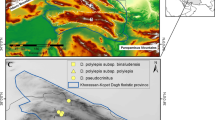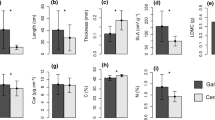Summary
We compared adaptive strategies in two plants of Venezuelan páramos (alpine areas): the widely distributed, caulescent, and pubescent Espeletia schultzii Wedd. with the acaulescent, nearly glabrous E. atropurpurea A.C. Smith which is restricted to mesic sites just above treeline. Both species occur together at 3,450 m, near treeline.
Physiologically, E. schultzii was more drought resistant than E. atropurpurea, and was better adapted for carbon dioxide fixation under low temperatures. The densely pubescent leaves of E. schultzii are highly reflective; this increases the intensity of light needed for photosynthetic saturation and influences leaf temperature. Leaf pubescence may reduce the level of insect predation.
Measurements of leaf productivity indicate higher values for E. atropurpurea during the rainy season and higher values for E. schultzii during the dry season. However, annual values of leaf productivity are similar for both species.
Benefits of specialization in E. atropurpurea include reduced costs for stem and leaf hair production, higher growth rates during the rainy season and the ability to grow beneath canopies of some larger arborescent species. Costs of specialization include lower growth rates during the dry season, great susceptibility to insect predation and restriction to low elevation, mesic sites.
Similar content being viewed by others
References
Baruch, Z.: Comparative physiological ecology in Espeletia: A giant rosette genus in the Venezuelan Andes. Ph. D. Dissertation, Duke University, Durham, N.C. (1975)
Baruch, Z.: Elevational differentiation in Espeletia schultzii (Compositae), a giant rosette plant of the Venezuelan páramos Ecology (in press, 1979)
Billings, W.D., Godfrey, P.J., Chabot, B.F., Bourque, D.P.: Metabolic acclimation to temperature in arctic and alpine ecotypes of Oxyria dygina. Arct. Alp. Res. 3, 277–289 (1971)
Chabot, B.F., Billings, W.D.: Origins and ecology of the Sierran alpine flora and vegetation. Ecol. Monogr. 42, 163–199 (1972)
Chardon, C.E.: Apuntes sobre el origen de la vida en los Andes. Rev. Acad. Col. Cienc. E. F. y N. 8, 185–202 (1951)
Cunningham, G.L., Strain, B.R.: Ecological significance of seasonal leaf variability in a desert shrub. Ecology 50, 400–408 (1969)
Ehleringer, J., Bjorkman, O., Mooney, H.A.: Leaf pubescence: effects on absorptance and photosynthesis in a desert shrub. Science 192, 376–377 (1976)
Godfrey, P.J.: Factors influencing the lower limits of alpine plants in the Medicine Bow Mountains of Southern Wyoming. Ph. D. Dissertation, Duke University. Durham, N.C. (1970)
Hedberg, O.: Features of Afroalpine plant ecology. Acta Phytogeogr. Suecica 49, 1–144 (1964)
Levin, D.A.: The role of trichomes in plant defense. Q. Rev. Biol. 48, 3–15 (1973)
Mabberley, D.J.: Evolution of the giant groundsels. Kew Bull. 28, 61–96 (1973)
Mooney, H.A., Harrison, A.T., Gulmon, S.L.: Photobleaching in high and low elevation plants at different radiation intensities. Am. Midl. Nat. 91, 254–256 (1974)
Roth, I.: Anatomia de las hojas de los paramos Venezolanos. II. Espeletia. Compositae. Acta Botanica Venezuelica 8, 281–310 (1973)
Scholander, P.F.L., Hammel, H.T., Broadstreet, E.D., Hemmingsen, E.A.: Sap pressure in vascular plants. Science 148, 339–346 (1965)
Smith, A.C., Koch, M.F.: The genus Espeletia: A study in phylogenetic taxonomy. Brittonia 1, 479–530 (1935)
Smith, A.P.: Population dynamics and life form of Espeletia in the Venezuelan Andes. Ph. D. Dissertation, Duke University, Durham, N.C. (1974a)
Smith, A.P.: Bud temperature in relation to nyctinastic leaf movement in an Andean giant rosette plant. Biotropica 6, 263–266 (1974b)
Smith, A.P.: The function of dead leaves in an Andean giant rosette plant. Biotropica (in press, 1978)
Smith, A.P.: The paradox of plant height in an Andean giant rosette plant. J. Ecol. (in press, 1979)
Stearns, S.: The evolution of life history traits. Ann. Rev. Ecol. Syst. 8, 145–171 (1977)
Tieszen, L.L., Johnson, D.A., Caldwell, M.M.: A portable system for the measurement of photosynthesis using 14-carbon dioxide. Photosynthetica 8, 151–160 (1974)
Author information
Authors and Affiliations
Rights and permissions
About this article
Cite this article
Baruch, Z., Smith, A.P. Morphological and physiological correlates of niche breadth in two species of Espeletia (Compositae) in the Venezuelan Andes. Oecologia 38, 71–82 (1979). https://doi.org/10.1007/BF00347825
Received:
Issue Date:
DOI: https://doi.org/10.1007/BF00347825




